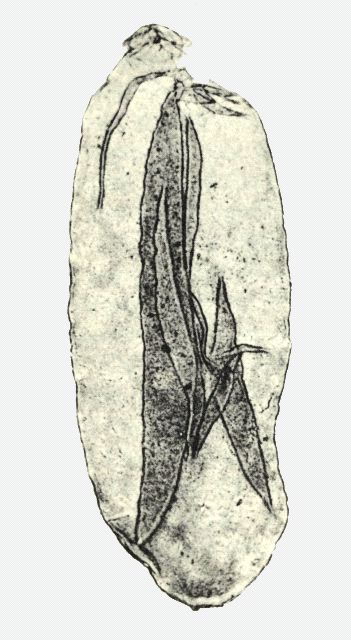Spermasporites
The advent of the seed as a means of reproduction was a revolution in the world of plants. The origin of seeds probably goes back to Middle Devonian time.
 (52 kb) The oldest known seed-producing plant was found in Belgium in rocks from the Famennian Age. After the Devonian, seed plants (spermatophytes) gradually became one of the most important groups of organisms on Earth, a group that includes the modern conifers (gymnosperms) and flowering plants (angiosperms) we encounter every day.
(52 kb) The oldest known seed-producing plant was found in Belgium in rocks from the Famennian Age. After the Devonian, seed plants (spermatophytes) gradually became one of the most important groups of organisms on Earth, a group that includes the modern conifers (gymnosperms) and flowering plants (angiosperms) we encounter every day.
In their quest for the origin of seed plants, a tiny Miguasha fossil has held the attention of paleobotanists for forty years. The fossil is that of a megaspore – a spore large enough to be visible to the naked eye – that goes by the name of Spermasporites devonicus. It shows all the characteristics of the primitive seeds that later became widespread in the Carboniferous Period.
When a modern plant produces ovules, macrospores in the fertile part (either a flower or a cone) undergo meiosis: two successive cellular divisions of one macrospore that produces four ovules. These four ovules form what we call a tetrad, which awaits fertilization by male pollen before becoming a seed – in other words, a plant embryo. Spermasporites “microfossils” have exactly the same tetrad arrangement as that of the first seed plants.
The search for the mysterious plant that produced this famous megaspore continues in various locations around the world, with particular attention given to a new Spermasporites site in eastern Greenland.

 (52 kb) The oldest known seed-producing plant was found in Belgium in rocks from the Famennian Age. After the Devonian, seed plants (spermatophytes) gradually became one of the most important groups of organisms on Earth, a group that includes the modern conifers (gymnosperms) and flowering plants (angiosperms) we encounter every day.
(52 kb) The oldest known seed-producing plant was found in Belgium in rocks from the Famennian Age. After the Devonian, seed plants (spermatophytes) gradually became one of the most important groups of organisms on Earth, a group that includes the modern conifers (gymnosperms) and flowering plants (angiosperms) we encounter every day.In their quest for the origin of seed plants, a tiny Miguasha fossil has held the attention of paleobotanists for forty years. The fossil is that of a megaspore – a spore large enough to be visible to the naked eye – that goes by the name of Spermasporites devonicus. It shows all the characteristics of the primitive seeds that later became widespread in the Carboniferous Period.
When a modern plant produces ovules, macrospores in the fertile part (either a flower or a cone) undergo meiosis: two successive cellular divisions of one macrospore that produces four ovules. These four ovules form what we call a tetrad, which awaits fertilization by male pollen before becoming a seed – in other words, a plant embryo. Spermasporites “microfossils” have exactly the same tetrad arrangement as that of the first seed plants.
The search for the mysterious plant that produced this famous megaspore continues in various locations around the world, with particular attention given to a new Spermasporites site in eastern Greenland.
Site map | Feedback | Links | Sources | Credits
Spermasporites
<< Archaeopteris | Spores by the millions >>



